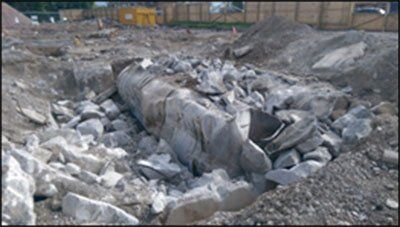Earth Environmental – August 2015 News
In the month of July 2015 we achieved a significant and very proud milestone in the evolution of Earth Environmental & Geotechnical, our 1000th project since formation of the company in March 2013.
We would like to take this opportunity in thanking all of our clients for their continued support. It has been a wonderful journey and we have very much enjoyed the extremely varied workload and different challenges faced. The future looks very promising and we hope to be able to continue unlocking development opportunities and offering pragmatic solutions to all our clients.
PROJECT NEWS
Fuel Retailing Station Site, Stockport
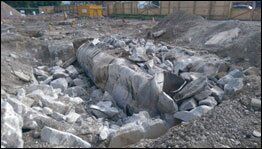 Following a phase of site investigation work we were commissioned by our client to supervise construction activities and validate the chemical status of soils from within tank excavations and around a petrol interceptor.
Following a phase of site investigation work we were commissioned by our client to supervise construction activities and validate the chemical status of soils from within tank excavations and around a petrol interceptor.
The construction activities revealed four previously unknown fuel tanks which were not shown on any petroleum licencing or as-built construction drawings.
After exhuming the recorded and unrecorded tanks we validated the tank sidewalls and bases to ensure that potential contaminants of concern, above risk based controlled water and human health assessment criteria, were not left in the ground.
Staff used photo-ionisation detectors and hand held XRF analysers to classify materials, which allowed for the segregation of clean and provisionally categorised contaminated soils.
In the event soil material above risk based assessment criteria were not found which saved the client a significant amount of previously budgeted construction time and money.
Farm Slurry Lagoon, North Wales
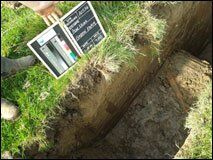 Our earthworks skills have been in demand on several farm slurry lagoon projects where site won materials have been used as low permeability liners and embankments.
Our earthworks skills have been in demand on several farm slurry lagoon projects where site won materials have been used as low permeability liners and embankments.
The Environment Agency are increasing vigilant about the pollution potential of slurry farm lagoons after a spate of recent earthwork failures. It is sometimes not appreciated that these structures often hold significant amounts of “water” sometimes close to the Reservoir Act threshold.
Ongoing work on a large lagoon in North Wales has involved us developing a Construction Quality Assurance Plan (CQA) and ensuring that laid cohesive materials comply with our compaction and material suitability specifications.
Solar Farm Projects, East Midlands
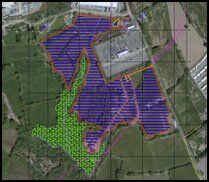 We have been increasingly involved in providing planning design advice to clients working on new solar farm projects. Many sites are within Coal Authority Development High Risk Areas and therefore require an assessment of risk posed from shallow abandoned mineworkings, adits and mine shafts.
We have been increasingly involved in providing planning design advice to clients working on new solar farm projects. Many sites are within Coal Authority Development High Risk Areas and therefore require an assessment of risk posed from shallow abandoned mineworkings, adits and mine shafts.
Future work will involve geotechnical investigations in order to establish ground conditions for solar panels and infrastructure.
Electricity Transformer Site, Manchester
We have been recently commissioned to investigate the proposed location of a new electricity sub-station adjacent to a hospital that is planned to be extended.
Despite difficult access, with abundant vegetation and trees were able to conduct a mixture of cable percussive and windowless sampling boreholes.
Future work will involve supporting the client with foundation design work and other submissions during the planning application.
Apartment Block, Manchester
Following an earlier phase of site investigation work we were contacted by the client to assist with the design of foundations for a new apartment block in the centre of Manchester.
Cable percussive boreholes were drilled to a depth of 30m with rotary coring follow on. Sandstone cores have been subjected to point load index, triaxial compression, P & S soundwaves, porosity and density testing.
Our interpretative report provided pile loading calculations based on Eurocode 7 partial factors of safety.
Remediation Project, Altrincham
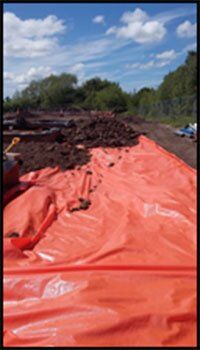 We were requested by a contractor to provide a Remediation Strategy involving a new residential development on an old landfill site. A previous remediation strategy by other consultants was considered to be too outdated and therefore a revised strategy was submitted to the local authority. This involved the re-use of site won materials and a reduced thickness of cover materials within front and rear garden areas.
We were requested by a contractor to provide a Remediation Strategy involving a new residential development on an old landfill site. A previous remediation strategy by other consultants was considered to be too outdated and therefore a revised strategy was submitted to the local authority. This involved the re-use of site won materials and a reduced thickness of cover materials within front and rear garden areas.
Our revised cover system included a marker geomembrane below the imported topsoil.
A later phase of gas membrane validation was conducted in accordance with “Good practice on the testing and verification of protection systems for buildings against hazardous ground gases” (CIRIA C735).


